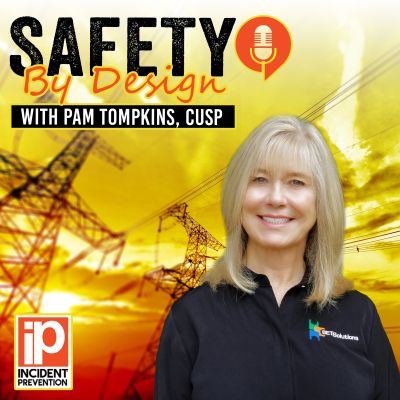SET Solutions LLC
Electric Power Safety Podcast Series
With insights drawn from her global consulting experience, Pam provides actionable strategies to design systems that protect both employees and organizations. She also previews her upcoming article series in Incident Prevention Magazine, which will provide a deep dive into transforming safety practices for utility professionals.

Safety By Design Podcasts
Safety by Design – Empowering Leadership and Employee Involvement with Pam Tompkins CSP, CUSP
Safety by Design – Empowering Leadership and Employee Involvement with Pam Tompkins CSP, CUSP
Read the article – https://incident-prevention.com/blog/safety-by-design-leadership-and-employee-involvement/
In this episode of Safety by Design, we welcome back safety expert Pam Tompkins, CUSP, CSP, to explore the foundational role of leadership and employee involvement in building effective safety systems. Based on her recent article in Incident Prevention magazine, Pam shares candid insights on overcoming middle management roadblocks, building measurable KPIs, and empowering workers at all levels—from new apprentices to seasoned frontline leaders. Tune in as Pam breaks down why involving the workforce is not optional but essential to safety success—and how organizations can align top-down and bottom-up strategies to protect their people and drive meaningful change.
Key Takeaways:
-
People are the foundation of safety—rules and programs only work when employees are actively involved in shaping and executing them.
-
Middle management is often the bottleneck in safety performance due to lack of field experience and misaligned priorities.
-
Effective safety systems require alignment across all levels: senior leaders, middle managers, and frontline employees.
-
KPIs must be tailored by role—senior leadership, middle management, and field crews should each have performance metrics tied to their unique influence on safety.
-
Safety is not just policy—it’s integration, and organizations must continuously measure, evaluate, and adapt their systems with employee feedback.
5 Relevant Questions & Answers:
Q1: Why is employee involvement essential to a successful safety system?
A1: Without employees, there is no safety system. Engagement ensures processes are practical, understood, and effectively integrated into real-world tasks.
Q2: What role does middle management play in the success—or failure—of safety programs?
A2: Middle managers often act as a roadblock if they prioritize production over safety or lack a true understanding of field-level risks.
Q3: How can senior leaders improve safety outcomes?
A3: By understanding the real “look of safety,” engaging directly with field teams, and holding themselves accountable for organizational risk tolerance.
Q4: What kind of KPIs are most effective for evaluating safety?
A4: Role-specific KPIs—like field engagement for executives or measurable improvements in hazard mitigation for frontline supervisors—are key.
Q5: What’s the danger of not aligning top-down and bottom-up safety efforts?
A5: It creates a culture of distrust, disengagement, and missed opportunities to improve safety. Full integration is necessary for success.
#UtilitySafety #WorkplaceSafety #SafetyLeadership #SafetyCulture #EmployeeEngagement #FrontlineSafety
Subscribe to Incident Prevention Magazine – https://incident-prevention.com/subscribe-now/
Register for the iP Utility Safety Conference & Expo – https://utilitysafetyconference.com/
Safety by Design: Transforming Utility Safety with Pam Tompkins, CUSP
In this episode of the Safety by Design podcast, Pam Tompkins, CUSP, shares her extensive 40-year journey in the utility safety industry. Pam dives into the critical importance of intentional safety planning and proactive assessments, emphasizing the need for quality over quantity in safety initiatives. With insights drawn from her global consulting experience, Pam provides actionable strategies to design systems that protect both employees and organizations. She also previews her upcoming article series in Incident Prevention Magazine, which will provide a deep dive into transforming safety practices for utility professionals.
Key Takeaways
- Proactive Assessments are Vital: Most safety assessments are reactive, conducted after incidents occur. Pam stresses the need for proactive assessments to prevent significant injuries or fatalities.
- Quality Over Quantity: Simply adding more safety initiatives doesn’t translate to better safety outcomes. Organizations must ensure their programs are effective and aligned.
- Importance of Standards: Leveraging ANSI and ISO standards can guide organizations in creating robust safety systems.
- Systemic Alignment Matters: Safety programs should align at all organizational levels to ensure effectiveness and consistency.
- Baseline and Metrics: Establishing a baseline and measurable goals for every safety initiative is essential for tracking success.
#SafetyByDesign #UtilitySafety #ProactiveSafety #CUSPLeadership #IncidentPrevention #WorkplaceSafety
OSHA Podcasts
Information Transfer: What OSHQ Requires
August 16, 2021
When it comes to OSHA’s rules for information transfer, it’s important to start with the hazard. Employers have the responsibility to identify and control known hazards to ensure worker safety.
When unknown hazards exist, the risk levels are elevated because workers may not have all the information they need to safely do the work. Pam Tompkins breaks down what OSHA requires for information transfer and what you can do to help ensure worker safety. This discussion was developed from our popular online, self-paced video-driven course, OSHA Electric Power Standards with Pam Tompkins & Matt Edmonds. This course was built to provide you with a simple and practical way to learn about OSHA’s Electric Power standards 1910.269 and 1926 Subpart V and provide you with expert insight and interpretations that help you understand the applications of the regulation. For more information on how you can purchase this course, visit https://ip-institute.com/osha-electric-power-standards/
16 min.
Understanding Why Minimum Approach Distance Regulations Changed
April 5, 2021
Altitudes, humidity and transient over voltages, oh my! When OSHA updated its 1910.269 standards back in 2014, it brought about a number of changes to minimum approach distance—or MAD—requirements to take into account the unique environmental changes that can impact air insulation. In this episode, Pam Tompkins goes over why those changes were made and how they help improve the safety of your workers. This discussion was developed from our popular online, self-paced video-driven course, OSHA Electric Power Standards with Pam Tompkins & Matt Edmonds. This course was built to provide you with a simple and practical way to learn about OSHA’s Electric Power standards 1910.269 and 1926 Subpart V and provide you with expert insight and interpretations that help you understand the applications of the regulation. For more information on how you can purchase this course, visit https://ip-institute.com/osha-electric-power-standards/
10 min.